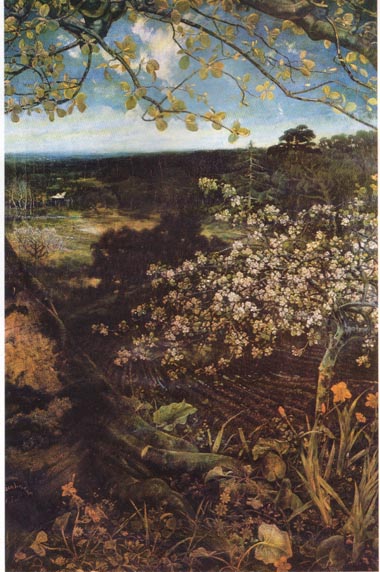
A Hymn to Spring
Cecil Gordon Lawson
Oil on canvas
circa 1871-1872; signed and dated 187- (last figure indistinct)
60 X 40 inches, 153 X 102 centimetres
Provenance. Guy Owen Esq.
Exhibited: London, Grosvenor Gallery, 1883, number 138, lent anonymously
Commentary by Hilary Morgan
Lawson rose to fame as a poetic landscape painter in the five years before his tragically early death at the age of thirty one. His main sources of inspiration were the Thames around Chelsea (he painted some twelve pictures of scenes in Cheyne Walk) and the richness of the English countryside.
He was born in Wellington in Shropshire and came to London with his family at the age of ten. His father, William Lawson (flourished 1819-1864) was a portrait painter and his brother Francis William Lawson (1842-1935) was a successful figure in the illustration revival of the 1860s and also a painter. Lawson received his art training from his father and especially from his brother. He too produced a number of illustrations at the beginning of his career but concentrated on painting, first exhibiting at the Royal Academy in 1870 and also showing at the New British Institution and the Society of British Artists. The artists he most admired as painters and illustrators were John Everett Millais, Frederick Walker, George John Pinwell and William Small (Lawson, 2). He worked in their naturalistic pastoral vein, although his own style is always distinctive. although he visited Ireland in 1873 and Holland, Belgium and Paris in 1874, England remained the main source of his subject matter. Between 1870 and 1878 the Lawson family lived in Cheyne Walk, Chelsea, and for part of this period they were the next door neighbors of Rossetti.
Lawson exhibited regularly at the Grosvenor Gallery from its second exhibition in 1878, creating a sensation in that year with the 'Minister's Garden' (Manchester City Art Gallery), a homage to Goldsmith. The following year he married Constance Philip, daughter of the sculptor J. Birnie Philip and herself an artist. They lived in Hastemere, Surrey, where Lawson painted the 'Atigust illoon' (Tate Gallery), exhibited at the Grosvenor Gallery in 187O and presented to the nation by the artist's widow. For' Lawson's last years were marked by increasing fame and declining health. He spent the winter of 1881 in the Riviera, but returned to London too soon and died in Chelsea in June 1882, Edmund Gosse published Lawson: A Memoir in 1883 and an illustrated article by Heseltine Owen, In Memoriam: Cecil Gordon Lawson appeared in the Magazine of Art for 1894.
This painting was based on Lawson's illustration 'Spring', published in the short-lived magazine Dark Blue (1871-1872) and was painted at the beginning of the artist's career when he was in his early twenties. As a teenager, he had devoted himself to 'careful studies of fruit and flowers, bits of landscapes and special clouds or blossoms or grasses' (Bryan's Dictionary of Artists (1919), III, 189). This period of detailed study, perhaps undertaken in a Ruskinian spirit, comes to fruition in the present painting with its minute observation of the foreground detail.
Lawson seems to have been fascinated by the problem of representing a distant landscape seen through a frame or screen of tree trunks and foliage set in the immediate foreground. This is a compositional feature of many of his famous views of 'Cheyne Walk' where the far bank of the Thames is seen through the riverside trees. It also appears in 'A Pastoral, in the Vale of Mieford, North Wales' (reproduced Lawson, 69) the 'Minister's Garden (Manchester City Art Gallery) and the'August Moon' (Tate Gallery). In the period of 'A Hymn to Spring, Lawson began his canvases from nature but completed them in the studio. 'A Pastoral' was exhibited in the Royal Academy in 1873, and in this the screen of birch trunks was added at a late stage in the composition (Owen, 67-68). Perhaps 'A Hymn to Spring' underwent a similar process as the artist intensified the richness of the composition.
It is probable that the painting was owned by Heseltine Owen, writer on Lawson, as it is reproduced in his article and as the later owner shares the same surname.
Bibliography
Morgan, Hilary, and Peter Nahum. Burne-Jones, the Pre-Raphaelites, and Their Century. London: Peter Nahum, 1989. Catologue number 138.
Owen, Heseltine. "In Memoriam: Cecil Gordon Lawson." Magazine of Art (1894), pp. 1-6, 64-70.
Victorian
Web
Artists
Last modified 14 April 2018